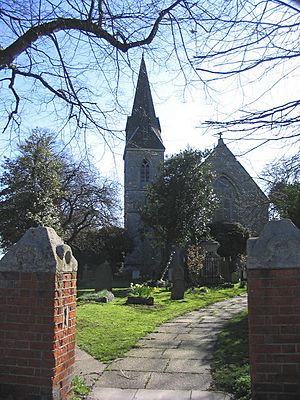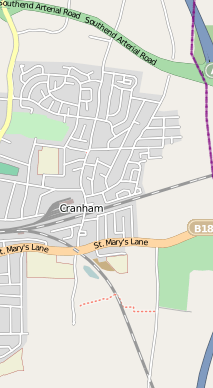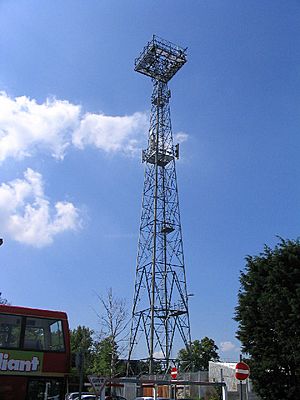Cranham facts for kids
Quick facts for kids Cranham |
|
|---|---|
 All Saints' Church, Cranham |
|
| OS grid reference | TQ575875 |
| • Charing Cross | 17.5 mi (28.2 km) WSW |
| London borough | |
| Ceremonial county | Greater London |
| Region | |
| Country | England |
| Sovereign state | United Kingdom |
| Post town | UPMINSTER |
| Postcode district | RM14 |
| Dialling code | 01708 |
| Police | Metropolitan |
| Fire | London |
| Ambulance | London |
| EU Parliament | London |
| UK Parliament |
|
| London Assembly |
|
Cranham is a residential area of east London, and part of the London Borough of Havering. It is located 17.5 miles (28 km) east-northeast of Charing Cross and comprises an extensive built-up area to the north and a low density conservation area to the south surrounded by open land. It was historically a rural village in the county of Essex and formed an ancient parish. It is peripheral to London, forming the eastern edge of the urban sprawl. The economic history of Cranham is characterised by a shift from agriculture to housing development. As part of the suburban growth of London in the 20th century, Cranham significantly increased in population, becoming part of Hornchurch Urban District in 1934 and has formed part of Greater London since 1965. The 2011 Census population of Cranham was included in Upminster.
Contents
History
Toponymy
| 1881 | 416 |
|---|---|
| 1891 | 465 |
| 1901 | 397 |
| 1911 | 489 |
| 1921 | 519 |
| 1931 | 1,240 |
| 1941 | war # |
| 1951 | 2,836 |
| # no census was held due to war | |
| source: UK census | |
Cranham is recorded in the Domesday Book of 1086 as comprising two manors. The smaller was in the north of the parish, and called Craohv and in 1201 as Craweno. It means 'spur of land frequented by crows' and is formed from the Old English 'crāwe' and 'hōh'. The larger was the Anglo-Saxon manor of Ockendon (Wochenduna) During the Middle Ages, and until around the 15th century, it was also known as Bishop's Ockendon because a large part of its area was owned by the Bishop of London.
Economic development
The parish is recorded in 1086 as being heavily wooded, supporting an agrarian way of life. Forest clearance was well advanced by the 15th century, with an increase in population and arable land; and there was a mill in Cranham. Cranham lay on brick earth and this gave rise to the Cranham Brick and Tile Company which was in operation from 1900 to 1920. Drury has suggested that early trade was with the nearby settlements of Romford and Hornchurch and with London via the River Thames at Rainham.
Urban development
In the 17th and 18th centuries manorial homes, including Cranham Hall, became attractive properties for merchants from the City of London. Initial attempts to expand the suburban estates from Upminster in the early 20th century ran into problems because of the lack of water supply. In 1922 sewage works for Upminster and Cranham were opened in Great Warley. In the 1930s land was used to develop some council housing and following the sale of the Benyon estate the pace of new building quickened. Cranham's location on the very edge of London's urban sprawl is explained by the halting effect on suburban house building of the introduction of the Metropolitan Green Belt and World War II. Thereafter building took place within the area bounded by the Southend Arterial Road in the north and St Mary's Lane in the south; and there were 615 council houses built by 1971.
Governance
Cranham forms part of the Hornchurch and Upminster UK Parliament constituency, and is partly within the Havering wards of Upminster and Cranham. Together these form the Upminster Area Committee. The current MP is Julia Lopez (politician). Each ward elects three councillors to Havering London Borough Council. All six councillors elected in 2010 for the two wards were the Upminster and Cranham Residents' Association candidates and the area is unusual in that the residents' association is strongly active. From 1945 to 1974 Cranham formed part of the Hornchurch constituency and from 1974 to 2010 it formed part of the Upminster constituency. Cranham is within the Havering and Redbridge London Assembly constituency.
Geography
Most of Cranham is located on the London Clay belt, with loam to the north and a gravel valley to the south. It rises to about 250 feet (76 m) in the north and to below 50 feet (15 m) in the south; with a ridge running east to west upon which All Saints' Church is located. Cranham forms a continuously built-up area with Upminster to the west, with open fields separating it from Harold Wood in the north, Great Warley to the east and North Ockendon to the southeast. Franks Wood and Cranham Brickfields are designated a Site of Importance for Nature Conservation with a habitat of ancient woodland, coppices, ditches, scrub, tall herbs and neutral grassland. The community forest centre for the extensive Thames Chase is located in the open land to the south east. Cranham forms part of the Upminster post town in the RM14 postcode district. Climate data for Cranham is taken from the nearest weather station at Greenwich, around 12 miles (19.3 km) southwest of All Saints church:
| Climate data for London (Greenwich) | |||||||||||||
|---|---|---|---|---|---|---|---|---|---|---|---|---|---|
| Month | Jan | Feb | Mar | Apr | May | Jun | Jul | Aug | Sep | Oct | Nov | Dec | Year |
| Record high °C (°F) | 14.0 (57.2) |
19.7 (67.5) |
21.0 (69.8) |
26.9 (80.4) |
31.0 (87.8) |
35.0 (95.0) |
35.5 (95.9) |
37.5 (99.5) |
30.0 (86.0) |
28.8 (83.8) |
19.9 (67.8) |
15.0 (59.0) |
37.5 (99.5) |
| Mean daily maximum °C (°F) | 8.3 (46.9) |
8.5 (47.3) |
11.4 (52.5) |
14.2 (57.6) |
17.7 (63.9) |
20.7 (69.3) |
23.2 (73.8) |
22.9 (73.2) |
20.1 (68.2) |
15.6 (60.1) |
11.4 (52.5) |
8.6 (47.5) |
15.2 (59.4) |
| Mean daily minimum °C (°F) | 2.6 (36.7) |
2.4 (36.3) |
4.1 (39.4) |
5.4 (41.7) |
8.4 (47.1) |
11.5 (52.7) |
13.9 (57.0) |
13.7 (56.7) |
11.2 (52.2) |
8.3 (46.9) |
5.1 (41.2) |
2.8 (37.0) |
7.5 (45.5) |
| Record low °C (°F) | −10.0 (14.0) |
−9.0 (15.8) |
−8.0 (17.6) |
−2.0 (28.4) |
−1.0 (30.2) |
5.0 (41.0) |
7.0 (44.6) |
6.0 (42.8) |
3.0 (37.4) |
−4.0 (24.8) |
−5.0 (23.0) |
−7.0 (19.4) |
−10.0 (14.0) |
| Average precipitation mm (inches) | 51.6 (2.03) |
38.2 (1.50) |
40.5 (1.59) |
45.0 (1.77) |
46.5 (1.83) |
47.3 (1.86) |
41.1 (1.62) |
51.6 (2.03) |
50.4 (1.98) |
68.8 (2.71) |
58.0 (2.28) |
53.0 (2.09) |
591.8 (23.30) |
| Average rainy days (≥ 1.0 mm) | 10.8 | 8.5 | 9.6 | 9.4 | 9.0 | 8.3 | 8.0 | 7.6 | 8.5 | 10.7 | 10.1 | 9.9 | 110.4 |
| Average snowy days | 4 | 4 | 3 | 1 | 0 | 0 | 0 | 0 | 0 | 0 | 1 | 3 | 16 |
| Average relative humidity (%) | 81.0 | 76.0 | 69.0 | 64.0 | 62.0 | 60.0 | 60.0 | 62.0 | 67.0 | 73.0 | 78.0 | 82.0 | 69.5 |
| Mean monthly sunshine hours | 49.9 | 71.4 | 107.1 | 159.8 | 181.2 | 181.0 | 192.1 | 195.1 | 138.9 | 108.1 | 58.5 | 37.4 | 1,480.5 |
| Source 1: Record highs and lows from BBC Weather, except August and February maximum from Met Office | |||||||||||||
| Source 2: All other data from Met Office, except for humidity and snow data which are from NOAA | |||||||||||||
| Climate data for London (Heathrow airport 1981−2010) | |||||||||||||
|---|---|---|---|---|---|---|---|---|---|---|---|---|---|
| Month | Jan | Feb | Mar | Apr | May | Jun | Jul | Aug | Sep | Oct | Nov | Dec | Year |
| Mean daily maximum °C (°F) | 8.1 (46.6) |
8.4 (47.1) |
11.3 (52.3) |
14.2 (57.6) |
17.9 (64.2) |
21.0 (69.8) |
23.5 (74.3) |
23.2 (73.8) |
19.9 (67.8) |
15.5 (59.9) |
11.1 (52.0) |
8.3 (46.9) |
15.2 (59.4) |
| Mean daily minimum °C (°F) | 2.3 (36.1) |
2.1 (35.8) |
3.9 (39.0) |
5.5 (41.9) |
8.7 (47.7) |
11.7 (53.1) |
13.9 (57.0) |
13.7 (56.7) |
11.4 (52.5) |
8.4 (47.1) |
4.9 (40.8) |
2.7 (36.9) |
7.4 (45.4) |
| Average precipitation mm (inches) | 55.2 (2.17) |
40.9 (1.61) |
41.6 (1.64) |
43.7 (1.72) |
49.4 (1.94) |
45.1 (1.78) |
44.5 (1.75) |
49.5 (1.95) |
49.1 (1.93) |
68.5 (2.70) |
59.0 (2.32) |
55.2 (2.17) |
601.7 (23.68) |
| Average rainy days (≥ 1.0 mm) | 11.1 | 8.5 | 9.3 | 9.1 | 8.8 | 8.2 | 7.7 | 7.5 | 8.1 | 10.8 | 10.3 | 10.2 | 109.6 |
| Mean monthly sunshine hours | 61.5 | 77.9 | 114.6 | 168.7 | 198.5 | 204.3 | 212.0 | 204.7 | 149.3 | 116.5 | 72.6 | 52.0 | 1,632.6 |
| Source: Met Office | |||||||||||||
Demography
| Cranham compared (2001 Census) | |||||
|---|---|---|---|---|---|
| Statistic | Upminster | Cranham | Havering | London | England |
| Ethnic group | |||||
| White | 12,354 | 11,930 | 213,421 | 5,103,203 | 44,679,361 |
| Asian | 133 | 120 | 4,088 | 866,693 | 2,248,289 |
| Black | 59 | 64 | 3,139 | 782,849 | 1,132,508 |
| Mixed | 87 | 78 | 2,298 | 226,111 | 643,373 |
| Chinese/Other | 41 | 19 | 827 | 70,928 | 231,424 |
| Population | |||||
| Total | 12,674 | 12,242 | 224,248 | 7,172,091 | 49,138,831 |
| Density(/hectare) | 5.62 | 18.67 | 19.97 | 45.62 | 3.77 |
| Households | 4,946 | 5,111 | 91,722 | 3,015,997 | 20,451,427 |
Demographic data is produced by the Office for National Statistics for the wards of Cranham and Upminster. All of Cranham is contained within these wards, however they also cover the connected settlement of Upminster and the rural outlier of North Ockendon. In 2001 the population of Upminster ward was 12,674 and Cranham ward was 12,242, giving a total population of 25,098. 80.95% in Upminster and 81.73% in Cranham report their religion as Christian, compared to 76.13% for Havering, 58.23% in London and 71.74% in England. 10.08% in Upminster and 10.46% in Cranham report having no religion, compared to 13.18% in Havering, 15.76% in London and 14.59% in England. With a black and minority ethnic population of 3% in 2001, Cranham and Upminster wards have the lowest Simpson index for ethnic diversity in London. The level of home ownership is atypically high compared to the rest of London and England, with over 90% of housing tenure under owner-occupation in both wards.
Economy
There are several short parades of shops; the largest on Front Lane, dominated by a Tesco Express store. The nearest significant activity centre identified in the London Plan is the local district centre at Upminster. Within Havering, Upminster is identified as the nearest of seven main town centres. There are a number of commercial businesses centred around the A127 Southend Arterial Road including a wholesale butcher, mushroom cultivator, caravan sales, and a sports equipment supplier. There are a limited number of hospitality venues, including pubs and a popular tandoori restaurant.
Transport
Front Lane is the main road through Cranham and runs north to south, connecting with the A127 road in the north. Approximately 0.5 miles (0.80 km) to the northeast it has a junction with the M25 motorway, which forms the outer ring road of London. Cranham is the location of the Upminster depot of the London Underground's District line. The nearest London Underground station is at Upminster, approximately 0.75 miles (1.21 km) to the west. The London-Tilbury-Southend line of the National Rail network passes through the area in two places, with the nearest station also at Upminster. There are Transport for London bus service to Upminster, Hornchurch, Romford, and Ockendon station on routes 248, 346 and 347.
Culture
All Saints' parish church was rebuilt in 1873 and is a grade II listed building. James Oglethorpe, the founder of the state of Georgia, now part of the United States of America, is buried with his wife at the centre of its chancel. The area around the church forms a conservation area. There is a second church called St Luke's further north on Front Lane. Cranham Hall, the former manor house, is a grade II listed building. There are two community associations that are both registered charities. The Cranham Community Association operates a broad range of sporting, self-improvement and hobby activities at Cranham Community Centre on Marlborough Gardens. Cranham Social Hall, with a capacity of 100, is separately operated by the Front Lane Community Association, and provides a limited range of activities. The main cultural and entertainment facilities of the borough are located in Hornchurch and Romford.





